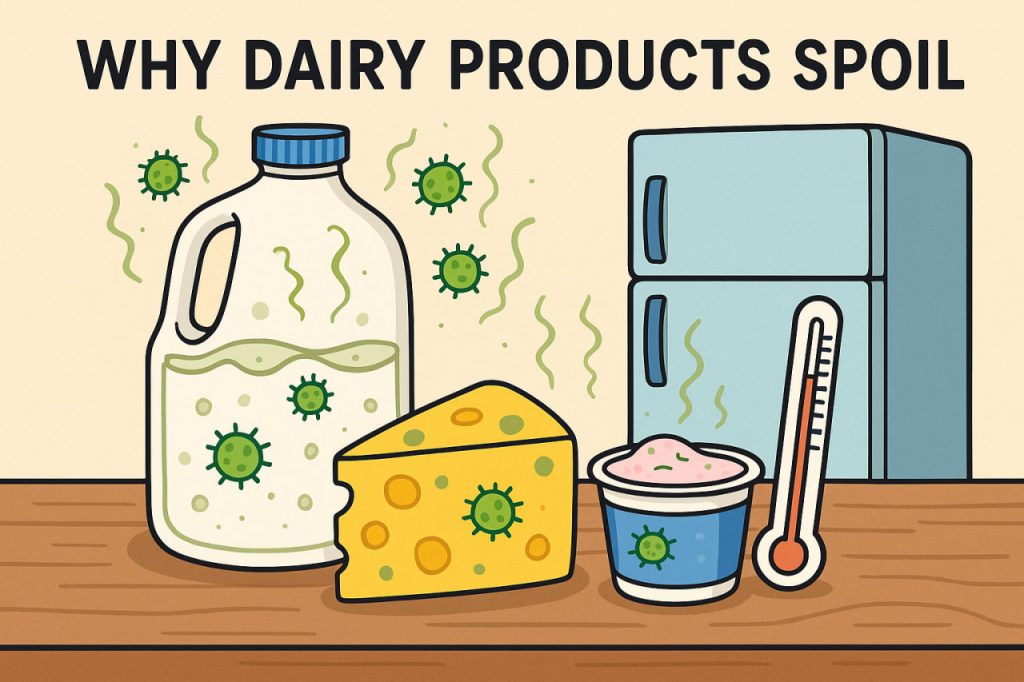Dairy products, such as milk, cheese, yogurt, and cream, are highly nutritious—but also highly perishable. They contain proteins, fats, water, and sugars that serve as an ideal breeding ground for microorganisms. Spoilage occurs when bacteria, yeasts, or molds begin to break down these components, producing foul smells, sour tastes, and unsafe conditions for consumption. Even under refrigeration, dairy products have a limited shelf life. Understanding why dairy spoils helps consumers handle, store, and consume these products more safely and efficiently. Spoilage is not always dangerous, but it often signals a decline in quality, nutrition, and taste.
Microbial Activity and Spoilage Mechanisms
Milk and other dairy products are especially vulnerable to microbial growth. After pasteurization, small numbers of heat-resistant bacteria may remain. When milk is exposed to air, lactic acid bacteria begin to multiply. These microbes break down lactose (milk sugar) into lactic acid, making the product sour and curdled. In cheeses, surface molds or unwanted bacteria can lead to sliminess, gas bubbles, or rancid odors. Yeasts can also grow in yogurts or creams with high sugar content, fermenting them into off-smelling substances. If dairy is left unrefrigerated or the packaging is damaged, spoilage accelerates rapidly due to uncontrolled microbial activity.
Environmental and Handling Factors
Storage conditions greatly influence spoilage speed. Temperature is critical—most dairy should be kept at or below 4°C (39°F). Even brief warming (e.g., leaving milk out on the table) allows microbes to grow exponentially. Humidity, exposure to light, and oxygen can also affect product stability. Containers that are not tightly sealed may allow contamination or air exposure, hastening spoilage. Cross-contamination—such as using a dirty spoon or mixing old and new milk—introduces new microbes. Even in sealed conditions, some spoilage occurs over time due to natural enzymatic changes and internal microbial shifts. Proper hygiene and storage are essential.
How to Detect and Prevent Spoilage
Common signs of spoilage include sour smell, curdling, discoloration, and off-flavors. Yogurt may separate or bubble, cheese may grow unusual molds, and milk may develop lumps or bitterness. To prevent spoilage, buy only as much dairy as you can consume within a few days. Store products immediately after purchase, and avoid leaving them at room temperature. Always check expiration dates, but also rely on sensory inspection before use. Vacuum sealing, refrigeration, and fermentation (e.g., turning milk into yogurt) can extend shelf life. If in doubt, it’s safer to discard the product—spoiled dairy can cause gastrointestinal illness.
Glossary
- Dairy products – foods made from milk, such as cheese, yogurt, and cream.
- Microorganisms – tiny living organisms, including bacteria and fungi, that can spoil food.
- Lactic acid – a compound produced by bacteria that turns milk sour.
- Pasteurization – the process of heating milk to kill harmful bacteria.
- Lactose – the natural sugar found in milk.
- Gastrointestinal illness – sickness caused by consuming contaminated food.


